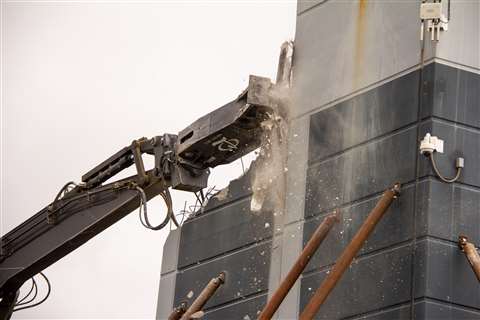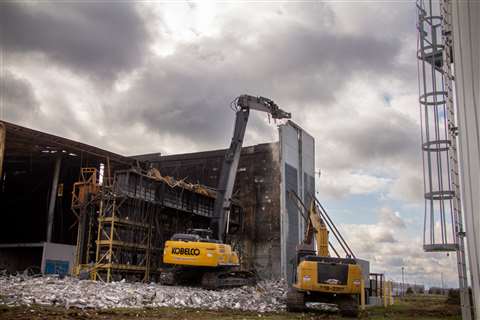The challenges of a high reach demolition
06 July 2022
In March 2022, the day after a fire engulfed a large distribution centre, local authorities called Casey-Bertram to provide immediate support to the fire department. The Indianapolis, USA-based demolition contractor travelled to Plainfield, Indiana to drag semi-truck trailers away from the 102,000 sq m (1.1 million sq ft) building, which allowed firefighters to concentrate their efforts on areas that were previously inaccessible and safely mitigate the fire.
After the fire was extinguished, Casey-Bertram was tasked with the teardown of several concrete pre-cast panels near key utility systems.
 Casey-Bertram needed a high reach for the special challenges of the demolition. (Photo: Company Wrench)
Casey-Bertram needed a high reach for the special challenges of the demolition. (Photo: Company Wrench)
Removing the pre-cast panels was challenging for two reasons — they were 14.3 m (47 ft) tall and within 9.1 m (30 ft) of critical utility systems that supported an adjacent distribution centre with over 1,000 employees.
These utility systems included two 300,000-gallon water tanks, a three-story battery recharging station for the centres’ forklifts, and multiple electrical transformers. It was imperative to remove the pre-cast panels within their footprint to avoid disrupting operations at the distribution centre.
Safe demolition
Normally, the CAT 330 and two Komatsu PC300s in Casey-Bertram’s fleet are enough to support a safe demolition project. However, in this situation, Casey-Bertram’s co-owner and president, Scott Casey knew he needed a high reach excavator. Casey contacted Company Wrench, a specialty equipment dealership headquartered in Ohio, to inquire about renting a high reach. The company offers a variety of high reach fronts ranging from 15 to 30 m (50 to 100 ft).
Doyle Burgess, Company Wrench’s territory sales manager, recommended a Kobelco SK300 with a 15 m high reach front and a LaBounty multi-demolition processor (MDP 20R).
Once the high reach excavator was delivered, Casey-Bertram initiated its plan to safely remove pre-cast panels from the building within the footprint. This process required all four machines and metal bracing to ensure the panels would collapse as intended. The high reach used the MDP 20R to crush the top concrete segments of the panel while the bracing held the panels in place.
The other three machines used their buckets to support and reposition the bracing as the high reach continued to make cuts with the MDP 20R. Once debris accumulated on the ground, Casey-Bertram’s excavators used shears, processors, and buckets to clear a path to allow the high reach to continue moving forward.
The process took about a week, avoiding damage to the utility systems while the distribution centre kept running.
“Our operators raved over the high reach and LaBounty MDP,” Casey said.
“They said the equipment worked perfectly and that the controls were very precise. Doyle sent out a machine that had the height we were looking for and to be far enough away from danger to work safely.”
 Contractor Casey-Bertram deploys the Kobelco high reach with LaBounty multi-demolition processor. (Photo: Company Wrench)
Contractor Casey-Bertram deploys the Kobelco high reach with LaBounty multi-demolition processor. (Photo: Company Wrench)
The first steps of a successful demolition project
It was ultimately determined the entire building needed to be demolished due to the damage caused by the fire. The next step is to remove the remaining pre-cast panels, which span approximately one mile in length.
This process will not require the same pinpoint accuracy that was used previously because the remaining sections are not close to utility systems.
The timetable on the complete demolition of the building is unknown due to several outside factors, but this first step of the process was considered a success by all parties involved.
STAY CONNECTED



Receive the information you need when you need it through our world-leading magazines, newsletters and daily briefings.
CONNECT WITH THE TEAM






